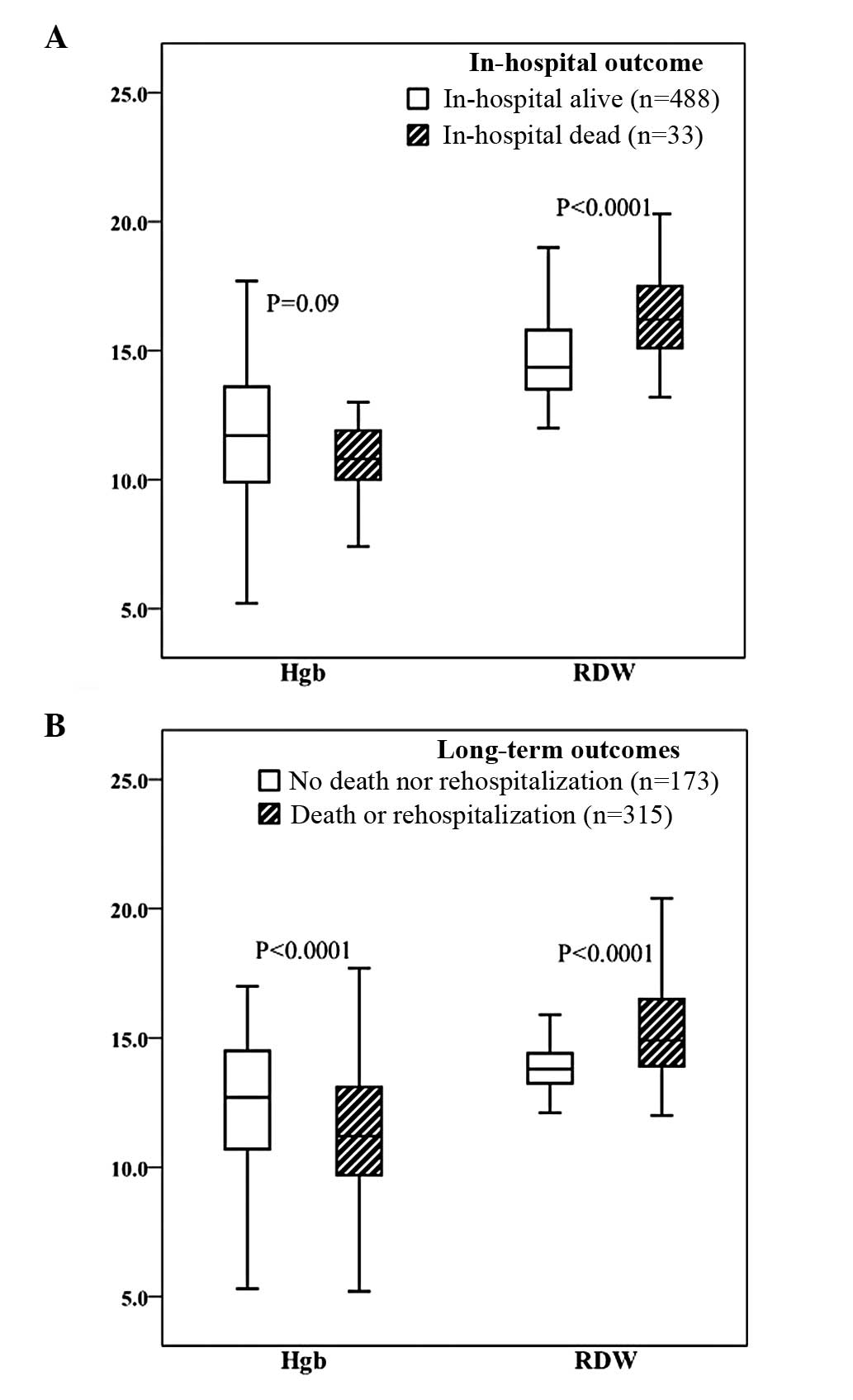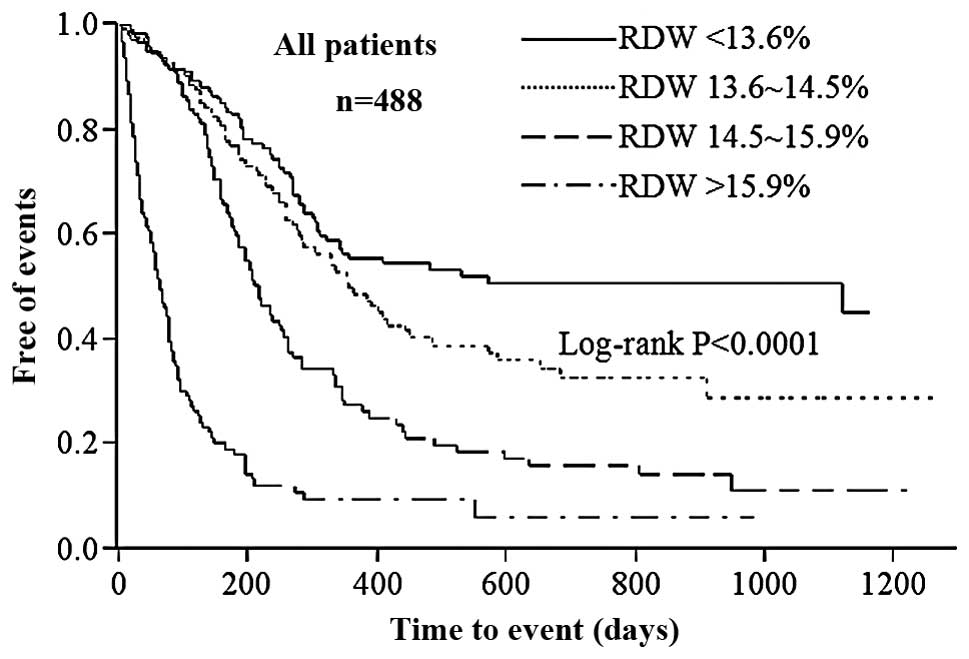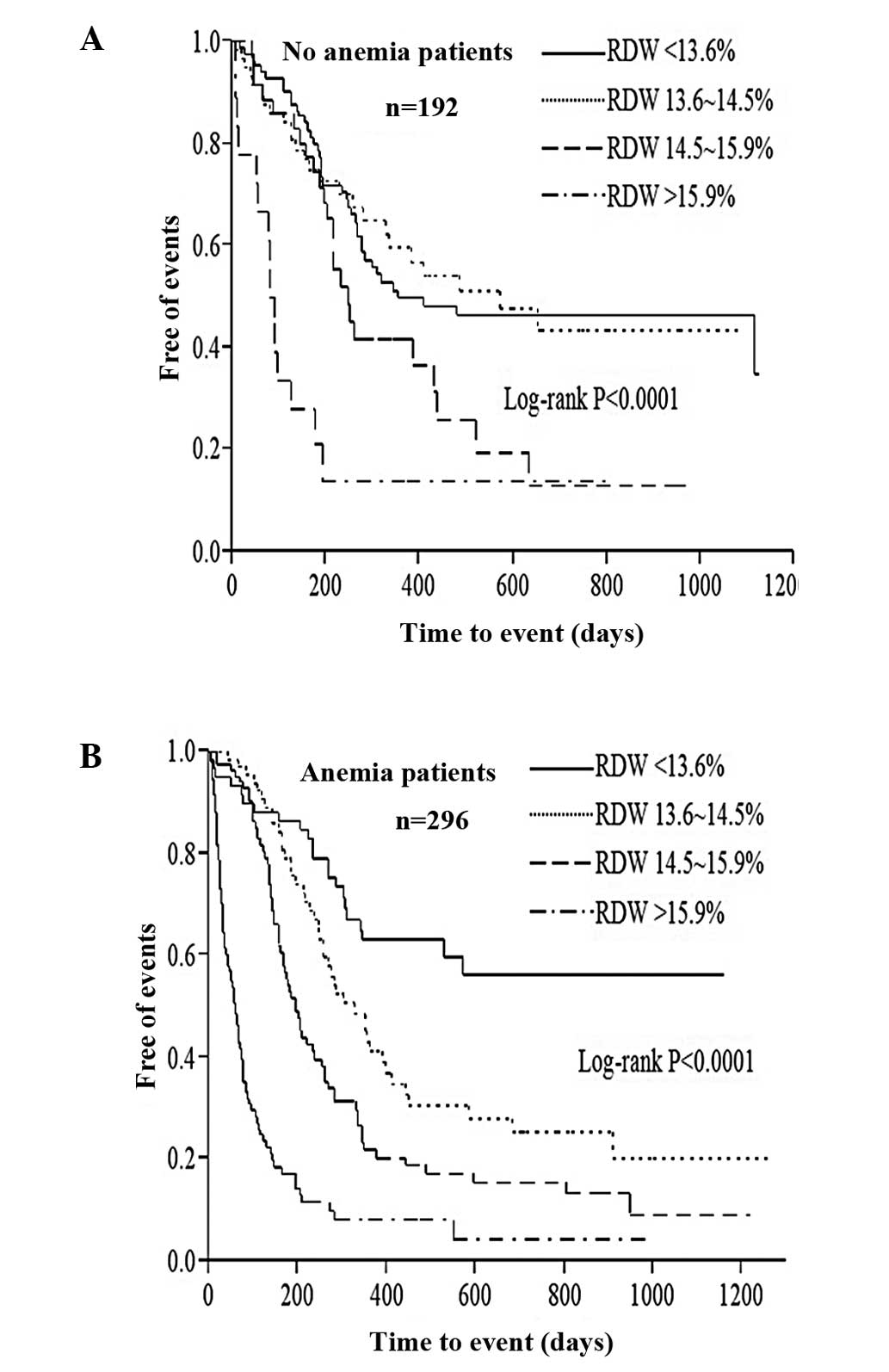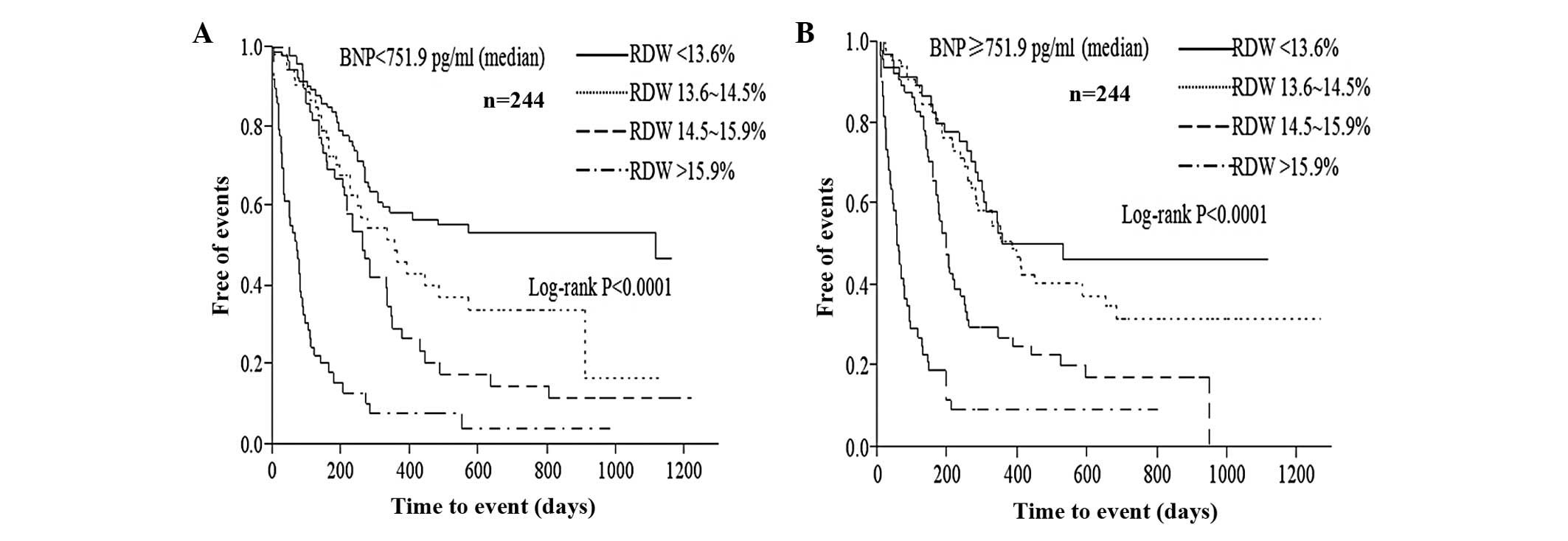Red cell distribution width predicts short- and long-term outcomes of acute congestive heart failure more effectively than hemoglobin
- Authors:
- Published online on: June 4, 2014 https://doi.org/10.3892/etm.2014.1755
- Pages: 600-606
Abstract
Introduction
Congestive heart failure (CHF) is often accompanied by high mortality rates. Therefore, accurate risk stratification is critically important in identifying high-risk patients who may benefit from advanced treatment (1–4). A number of clinical variables and biological markers have been applied over the last decade in predictive models of survival for patients with CHF (5,6), including inflammatory cytokines (7,8) high-sensitivity C-reactive protein (CRP) (9) natriuretic peptides (10,11) neurohormones (12) and oxidative stress (13), all of which are useful for diagnosis and prognosis. However, these biomarkers are very expensive to analyze and cost effectiveness must be considered when including markers in predictive models.
Anemia is a common feature of patients with CHF and it has important implications for the prognosis and treatment of CHF (14–17). A cause-and-effect relationship between anemia and CHF has not been demonstrated. Red blood cell distribution width (RDW) is a measure of the size variability in the red blood cell population and it is calculated as the standard deviation (SD) of the distribution of RDW divided by the mean corpuscular volume. Several studies have confirmed that RDW predicts mortality in acute coronary syndrome (18,19) and heart failure (20–22). However, the predictive value of RDW for in-hospital, and long-term outcomes for acute CHF and acute CHF predictive value relative to hemoglobin (Hgb) and anemia remain unknown (23).
The present study therefore investigated whether RDW is useful for risk stratification in patients hospitalized with acute exacerbation of CHF and analyzed the prognostic value of RDW compared with that of Hgb levels and anemia status.
Materials and methods
Patients
Patients with acute onset of CHF were consecutively enrolled in an observational study between January 2007 and December 2009. All patients were hospitalized at the cardiac care unit (CCU) of Juntendo University Hospital (Tokyo, Japan). Demographic and clinical information, as well as age, gender, New York Heart Association (NYHA) functional class, history of cigarette smoking, ischemic heart disease, hypertension, hyperlipidemia, atrial fibrillation, diabetes mellitus, chronic renal failure, hemodialysis and medications taken upon admission were obtained from medical records. Body mass index was calculated from height and weight data. Cardiac structure and function was assessed by echocardiography using a hematology analyzer (HF-3000, Chengdu, China).
The patients were followed up by telephone, personal interviews and by reviewing electronic medical records. The endpoint for short-term outcomes was in-hospital mortality. Mortality from all causes and readmission to hospital with the onset of CHF were long-term endpoints. The end of the follow-up was June 2010. The current study was performed according to the ethics policies of Juntendo University Hospital and was approved by the internal review board. Informed consent was obtained from the patient.
Laboratory measurements
Blood samples were obtained immediately upon admission to the CCU and analyzed as quickly as possible in the clinical chemistry laboratory. Anemia was defined as Hgb <12 g/dl in women and <13 g/dl in men, according to the World Health Organization (WHO) criteria. Renal function was evaluated as the estimated glomerular filtration rate (eGFR), calculated according to the simplified modification of diet in renal disease (MDRD) equation: eGFR (ml/min/1.73 m2) = 186 × [serum creatinine (Scr)]−1.154 × (age)−0.203 × (0.742 if female) where Scr is the serum creatinine level in mg/dl.
Statistical analysis
Discrete variables were presented as frequency counts and ratios (%). Continuous variables were analyzed based on a normal distribution using the Shapiro-Wilk test. They were expressed as mean ± SD when normally distributed, or as medians with inter-quartile ranges (IQRs) if not. Proportions and means or medians were compared using the χ2 test, the two-tailed independent Student’s t-test, one-way analysis of variance (ANOVA) and the Wilcoxon or Kruskal-Wallis one-way ANOVA test. Univariable correlations were examined using the Pearson’s correlation coefficient in the context of normality, whereas correlations among non-normally distributed variables were examined using the Spearman’s rho test. Variables with a retention P-value of 0.10 in the univariate analysis were entered into a multivariable linear regression model. Variables with non-normal distributions were log-transformed prior to being entered into this model.
Independent predictors of short- and long-term outcomes were identified using the logistic regression and Cox proportional hazard models, respectively. Kaplan-Meier accumulated survival curves were constructed and log-rank values were calculated to assess their statistical significance.
All data were analyzed using JMP 8.0 (SAS Institute, Inc., Cary, NC, USA) and SPSS 18.0 (SPSS Inc., Chicago, IL, USA). P<0.05 was considered to indicate a statistically significant difference.
Results
Patient characteristics
The current study comprised 521 patients with acute onset CHF from a wide range of age groups [72 (64, 80) years]. The median (IQR) values of RDW and mean level of Hgb overall were 14.5 (13.6, 15.9)% and 11.7±2.5 g/dl, respectively. Based on the WHO criteria, 324 (62.2%) patients were diagnosed with anemia. Among the patients, 192 (36.9%), 200 (38.4%) and 129 (24.8%) were classified as NYHA functional classes II, III and IV, respectively. Table I shows the patient characteristics upon admission, grouped according to quartiles of RDW. Patients with a higher RDW significantly differed from the others in terms of age, Hgb, anemia, NYHA classification, left ventricular ejection fraction (LVEF), B-type natriuretic peptide (BNP), lipid profiles [specifically, total cholesterol (TC), low density lipoprotein cholesterol (LDL-C), high density lipoprotein cholesterol (HDL-C) and triglycerides (TG)] blood urea nitrogen (BUN), eGFR, CRP and loop diuretics at presentation.
Table IBaseline clinical characteristics of patients at time of admission, grouped according to red blood cell distribution width. |
Predictors of RDW values
Univariate analysis showed that age, history of CRF, hemodialysis at presentation, history of diabetes mellitus, Hgb, anemia, NYHA classification, LVEF, BNP, TC, LDL-C, HDL-C, TG, BUN, eGFR and loop diuretics at presentation were significantly correlated with RDW (P<0.05, data not shown). However, further multivariate analysis revealed Hgb, BNP, eGFR and HDL-C as independent predictors of RDW (Table II).
Table IIMultiple linear regression assessing independent predictors of red blood cell distribution width. |
Prediction value of in-hospital mortality and long-term outcome
Thirty-three (6.3%) patients succumbed in hospital. After a median follow-up of 24 months (range, 6–42 months), 315 (64.5%) patients reached the endpoint of mortality or re-hospitalization.
The RDW values were significantly higher in the group that succumbed while in hospital (DIH) compared with the group that remained alive while in hospital (AIH) [16.2 (15.1, 17.6)% vs. 14.4 (13.5, 15.8)%, P<0.0001)]. However, Hgb did not significantly differ between the two groups (11.0±1.8 vs. 11.8±2.6 g/dl, P>0.05; Fig. 1A). Logistic regression analysis showed that in-hospital mortality was significantly associated with RDW, NYHA (IV-III), eGFR and CRP (P<0.05), but not with Hgb (Table III).
Throughout the median 24 months of follow-up, both Hgb and RDW significantly differed between the two groups (Fig. 1B). The mean levels of Hgb in patients that reached an endpoint or did not reach an endpoint were 11.4±2.5 and 12.5±2.4 g/dl, respectively (P<0.0001); the median (IQR) values of RDW were 14.9 (13.9, 16.5)% and 13.8 (13.3, 14.4)% respectively (P<0.0001).
Kaplan-Meier survival curves for mortality from all causes and readmission to hospital demonstrated that rates of endpoints were significantly higher among patients with a higher RDW (Fig. 2; Log-rank P<0.0001). The graded increased probability of endpoints with increasing RDW quartiles during follow-up persisted regardless of the presence of anemia (Fig. 3) and variations in BNP level (Fig. 4). The univariate Cox proportional hazard model analysis (Table IV) associated Hgb [per SD increase, hazard ratio (HR), 0.72; 95% CI, 0.64–0.81; P<0.0001) and RDW (per SD increase, HR, 2.25; 95% CI, 2.02–2.49; P<0.0001] with higher risks of reaching endpoints. After adjustment in the multivariate Cox proportional hazard model analysis (Table IV), RDW remained a significant risk factor (per SD increase, HR, 2.19; 95% CI, 1.92–2.50; P<0.0001), whereas Hgb did not remain a predictive value (per SD increase, HR, 1.01; 95% CI, 0.96–1.13; P=0.86). In this final adjusted model, the other independent predictors included LVEF (per SD increase, HR, 0.81; 95% CI, 0.71–0.92; P=0.0016), age (10 years increase, HR, 1.19; 95% CI, 1.07–1.34; P=0.0017) and NYHA classes III and IV (HR, 1.52; 95% CI, 1.15–2.03; P=0.0029).
Discussion
The results of the present study revealed that RDW may act as a powerful independent predictive factor for short- and long-term outcomes in patients with acute exacerbation of CHF and that this prognostic value remains significant even after adjustment for other known prognostic factors. The correlation between RDW and the long-term outcomes of patients with acute CHF provides prognostic data upon which to base risk factors and persists regardless of the levels of Hgb or BNP. Other prognostic markers identified in the current study were age, LVEF and NYHA class, all of which were consistent with the findings of published models on heart failure.
The RDW is a measurement of the size variation among circulating red cells and is calculated as part of the routine complete blood count (24). The RDW, along with mean cell volume (MCV), is useful in the differential diagnosis of the causes of anemia (25). The normal range for RDW is between 11.5% and 14.5%, and higher RDW values represent a greater variability in cell size (24,25). The median RDW value in the present study was 14.5%, indicating that half of the patients had an RDW value that was above the upper limit of the normal range.
Anemia has convincingly served as a powerful predictor of re-hospitalization rates and survival in CHF (14,26,27). Several mechanisms have been proposed to explain the association between anemia and outcomes of heart failure, including nutritional deficiencies, impaired renal function, inadequate production of erythropoietin, inflammatory stress (such as circulating cytokines and chemokines that predict a higher mortality risk in the population) and the impact of comorbidities (4,17,28). In addition, the hemodynamic changes accompanying severe anemia, including increased preload, reduced peripheral vascular resistance and increased cardiac output, may ultimately lead to a detrimental increase in left ventricular mass (15,27). Any or all of these mechanisms may also influence RDW.
The RDW values become elevated under conditions of increased red cell destruction or ineffective red cell production (24). Increased RDW may represent a nutritional deficiency (iron, vitamin B12 or folic acid), bone marrow depression or chronic inflammation (24,25). Inflammatory cytokines are predictors of the prognosis of heart failure. Proinflammatory cytokines inhibit erythropoietin-induced erythrocyte maturation, which is partly reflected by an increase in RDW (29). Therefore, RDW may serve as an integrative marker of multiple pathological processes that are involved in heart failure, including the above conditions, which are often found in patients with heart failure (30) This may explain why RDW values correlate with disease severity and are associated with prognosis. The current study identified Hgb, BNP, eGFR and HDL-C as independent predictors of RDW; eGFR reflected renal function and HDL-C reflected nutritional status. However, a significant relationship was not identified between RDW and inflammatory indices (CRP and UA) in the multivariate regression model.
The most notable finding of the present study was that after multivariate adjustment of all the patient data, RDW, but not Hgb, was predictive of both in-hospital and long-term outcomes. This indicates that the pathophysiology leading to increased RDW may affect outcomes in chronically ill patients, irrespective of anemia status. The finding may be explained as follows. As noted above, many variables are associated with anemia, such as inflammatory factors, nutritional deficiencies, renal dysfunction and inadequate erythropoietin production. The relationships among these variables and outcomes may be more directly reflected through their impact on RDW, than on Hgb. This was demonstrated in the present study as RDW predicted mortality in patients with and without anemia.
Secondly, RDW may be an earlier marker of prognosis than Hgb as it reflects the early steps in the complex processes that lead to anemia. At this point red blood cell production is ineffective and red blood cell destruction increases, but Hgb remains within the normal range. In addition, all the patients in the current study had the onset of acute CHF. Hemodynamic changes during this acute phase, such as fluid retention, interfere with the accurate measurement of Hgb, which may generate misinformation about the status of anemia. Under these circumstances, RDW is likely to be a more appropriate marker of baseline anemia status.
Another notable finding of the present study was that after stratifying levels of BNP, RDW remained associated with long-term outcomes. Although BNP is considered to be a powerful predictor of CHF outcomes (31), a single biomarker is insufficient to assess the outcomes of the entire study population due to disease heterogeneity. A recent multiple-marker approach has been suggested for risk stratification of heart failure (32–34). The current study found that a graded increased probability of endpoints with increased RDW during follow-up in groups with low and high BNP indicated that the predictive value of RDW was independent of that of BNP. Due to its widespread availability and cost-effectiveness, the inclusion of RDW in multiple marker models of CHF risk stratification is recommended.
The RDW is a readily available and inexpensive test for patients with CHF. Results are reported together with a complete differential blood count and no extra cost is incurred. The RDW has a better prognostic value than Hgb for both short- and long-term outcomes in patients with decompensated CHF and the prognostic value in long-term outcomes remains significant regardless of anemia or BNP levels. Thus, RDW appears to carry prognostic information concerning states other than anemia. In the future, the inclusion of RDW in a combined model for the risk stratification of patients with acute exacerbation of CHF is recommended. Further study is required to clarify the detailed mechanisms of the effect of elevated RDW in CHF.
References
|
Levy D, Kenchaiah S, Larson MG, et al: Long-term trends in the incidence of and survival with heart failure. N Engl J Med. 347:1397–1402. 2002. View Article : Google Scholar : PubMed/NCBI | |
|
Mueller C, Laule-Kilian K, Christ A, et al: Inflammation and long-term mortality in acute congestive heart failure. Am Heart J. 151:845–850. 2006. View Article : Google Scholar : PubMed/NCBI | |
|
Roger VL, Weston SA, Redfield MM, et al: Trends in heart failure incidence and survival in a community-based population. JAMA. 292:344–350. 2004. View Article : Google Scholar : PubMed/NCBI | |
|
Cowie MR, Wood DA, Coats AJ, et al: Survival of patients with a new diagnosis of heart failure: a population based study. Heart. 83:505–510. 2000. View Article : Google Scholar : PubMed/NCBI | |
|
Xue Y, Chan J, Sakariya S and Maisel A: Biomarker-guided treatment of congestive heart failure. Congest Heart Fail. 16(Suppl 1): S62–S67. 2010. View Article : Google Scholar : PubMed/NCBI | |
|
Allen LA: Use of multiple biomarkers in heart failure. Curr Cardiol Rep. 12:230–236. 2010. View Article : Google Scholar | |
|
Vistnes M, Christensen G and Omland T: Multiple cytokine biomarkers in heart failure. Expert Rev Mol Diagn. 10:147–157. 2010. View Article : Google Scholar : PubMed/NCBI | |
|
Bozkurt B, Mann DL and Deswal A: Biomarkers of inflammation in heart failure. Heart Fail Rev. 15:331–341. 2010. View Article : Google Scholar : PubMed/NCBI | |
|
Araújo JP, Lourenço P, Azevedo A, et al: Prognostic value of high-sensitivity C-reactive protein in heart failure: a systematic review. J Card Fail. 15:256–266. 2009.PubMed/NCBI | |
|
Rehman SU and Januzzi JL Jr: Natriuretic peptides for guiding heart failure therapy. Compr Ther. 34:32–40. 2008.PubMed/NCBI | |
|
Adams KF Jr, Felker GM, Fraij G, et al: Biomarker guided therapy for heart failure: focus on natriuretic peptides. Heart Fail Rev. 15:351–370. 2010. View Article : Google Scholar : PubMed/NCBI | |
|
Odedra K and Ferro A: Neurohormones and heart failure: the importance of aldosterone. Int J Clin Pract. 60:835–846. 2006. View Article : Google Scholar : PubMed/NCBI | |
|
Trachtenberg BH and Hare JM: Biomarkers of oxidative stress in heart failure. Heart Fail Clin. 5:561–577. 2009. View Article : Google Scholar : PubMed/NCBI | |
|
Belziti CA: Prevalence of anemia in heart failure and its effects on prognosis. Expert Rev Cardiovasc Ther. 7:131–138. 2009. View Article : Google Scholar : PubMed/NCBI | |
|
Salisbury AC and Kosiborod M: Outcomes associated with anemia in patients with heart failure. Heart Fail Clin. 6:359–372. 2010. View Article : Google Scholar : PubMed/NCBI | |
|
He SW and Wang LX: The impact of anemia on the prognosis of chronic heart failure: a meta-analysis and systemic review. Congest Heart Fail. 15:123–130. 2009. View Article : Google Scholar : PubMed/NCBI | |
|
Ghali JK: Anemia and heart failure. Curr Opin Cardiol. 24:172–178. 2009. View Article : Google Scholar | |
|
Dabbah S, Hammerman H, Markiewicz W and Aronson D: Relation between red cell distribution width and clinical outcomes after acute myocardial infarction. Am J Cardiol. 105:312–317. 2010. View Article : Google Scholar : PubMed/NCBI | |
|
Nabais S, Losa N, Gaspar A, et al: Association between red blood cell distribution width and outcomes at six months in patients with acute coronary syndromes. Rev Port Cardiol. 28:905–924. 2009.PubMed/NCBI | |
|
Förhécz Z, Gombos T, Borgulya G, et al: Red cell distribution width: a powerful prognostic marker in heart failure. Eur J Heart Fail. 12:4152010.PubMed/NCBI | |
|
Al-Najjar Y, Goode KM, Zhang J, et al: Red cell distribution width: an inexpensive and powerful prognostic marker in heart failure. Eur J Heart Fail. 11:1155–1162. 2009. View Article : Google Scholar : PubMed/NCBI | |
|
van Kimmenade RR, Mohammed AA, Uthamalingam S, et al: Red blood cell distribution width and 1-year mortality in acute heart failure. Eur J Heart Fail. 12:129–136. 2010.PubMed/NCBI | |
|
Pascual-Figal DA, Bonaque JC, Redondo B, Caro C, Manzano-Fernandez S, Sánchez-Mas J, Garrido IP and Valdes M: Red blood cell distribution width predicts long-term outcome regardless of anaemia status in acute heart failure patients. Eur J Heart Fail. 11:840–846. 2009. View Article : Google Scholar : PubMed/NCBI | |
|
Evans TC and Jehle D: The red blood cell distribution width. J Emerg Med. 9:71–74. 1991. View Article : Google Scholar | |
|
Viswanath D, Hegde R, Murthy V, et al: Red cell distribution width in the diagnosis of iron deficiency anemia. Indian J Pediatr. 68:1117–1119. 2001. View Article : Google Scholar : PubMed/NCBI | |
|
Crosato M, Steinborn W and Anker SD: Anemia in chronic congestive heart failure: frequency, prognosis, and treatment. Heart Fail Monit. 4:2–6. 2003.PubMed/NCBI | |
|
Terrovitis JV, Anastasiou-Nana M, Kaldara E, et al: Anemia in heart failure: pathophysiologic insights and treatment options. Future Cardiol. 5:71–81. 2009. View Article : Google Scholar : PubMed/NCBI | |
|
Felker GM, Adams KF Jr, Gattis WA and O’Connor CM: Anemia as a risk factor and therapeutic target in heart failure. J Am Coll Cardiol. 44:959–966. 2004. View Article : Google Scholar : PubMed/NCBI | |
|
Pierce CN and Larson DF: Inflammatory cytokine inhibition of erythropoiesis in patients implanted with a mechanical circulatory assist device. Perfusion. 20:83–90. 2005. View Article : Google Scholar : PubMed/NCBI | |
|
Felker GM, Allen LA, Pocock SJ, et al; CHARM Investigators. Red cell distribution width as a novel prognostic marker in heart failure: data from the CHARM Program and the Duke Databank. J Am Coll Cardiol. 50:40–47. 2007. View Article : Google Scholar : PubMed/NCBI | |
|
Maisel A: B-type natriuretic peptide levels: diagnostic and prognostic in congestive heart failure: what’s next? Circulation. 105:2328–2331. 2002. | |
|
Ikonomidis I, Michalakeas CA, Lekakis J, et al: Multimarker approach in cardiovascular risk prediction. Dis Markers. 26:273–285. 2009. View Article : Google Scholar | |
|
Velagaleti RS, Gona P, Larson MG, et al: Multimarker approach for the prediction of heart failure incidence in the community. Circulation. 122:1700–1706. 2010. View Article : Google Scholar : PubMed/NCBI | |
|
Yin WH, Chen JW, Feng AN, et al: Multimarker approach to risk stratification among patients with advanced chronic heart failure. Clin Cardiol. 30:397–402. 2007. View Article : Google Scholar : PubMed/NCBI |













